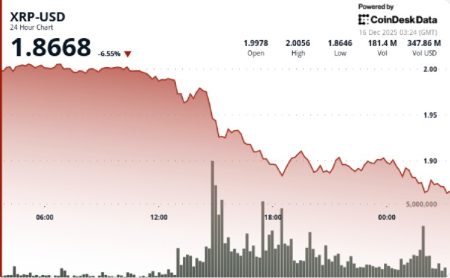European Central Bank Accelerates Digital Euro Development, Targeting 2029 Launch
European Council Pushes for Swift Implementation of Central Bank Digital Currency
In a significant development for European monetary policy, the European Central Bank (ECB) has been directed to expedite the development of its central bank digital currency (CBDC), the digital euro. ECB President Christine Lagarde announced on Friday that the institution is entering the “next and final phase” of this ambitious project, with a potential launch timeline that could see Europeans using the digital currency by 2029. This acceleration comes at the direct request of the European Council, signaling high-level political support for modernizing the eurozone’s payment infrastructure in an increasingly digital economy.
“The European Council has asked us and all those involved to accelerate the process so that we can roll out the digital euro as early as possible,” Lagarde stated in her announcement. She emphasized the symbolic importance of this initiative, describing the euro as “a symbol of trust in our common destiny.” The digital euro project represents one of the most significant evolutions of European monetary policy since the introduction of the physical euro in 2002, aiming to complement physical banknotes rather than replace them entirely. According to the ECB, this digital alternative would extend the benefits of cash to the digital sphere while preserving the unifying role the euro plays across the continent.
What Sets the Digital Euro Apart from Cryptocurrencies and Stablecoins
The digital euro differs fundamentally from cryptocurrencies and stablecoins in several crucial aspects, despite some technical similarities. While it will borrow certain “key design principles” from blockchain technology, the ECB has confirmed that the digital euro will not rely on distributed ledger technology for transaction settlement. Instead, it will function as a direct digital representation of the fiat euro, issued and backed by the central bank itself. This distinction places it in a different category from private stablecoins like Tether or Circle’s USDC, which are issued by companies rather than sovereign institutions.
This centralization has sparked significant debate within cryptocurrency communities, many of whom have expressed concerns about privacy, government control, and the potential for authorities to freeze funds. These criticisms highlight the philosophical tension between the decentralized ethos of many cryptocurrency advocates and the inherently centralized nature of CBDCs. However, proponents of the digital euro point out that private stablecoin issuers already exercise similar powers to freeze assets linked to criminal activity, suggesting that concerns about centralized control may not be unique to government-issued digital currencies. When contacted by Decrypt for clarification regarding the protocols for freezing funds within the digital euro system, the ECB press office did not respond, leaving some questions about user protections unanswered.
Implementation Timeline and Financial Investment
According to a detailed blog post published by the ECB, the path to implementation will require several more regulatory and technical milestones. The European Parliament must first pass the necessary regulations establishing the legal framework for the digital euro, a process expected to conclude in 2026. If successful, the ECB plans to conduct initial pilot exercises and limited transactions by mid-2027, testing the system’s functionality and security before a comprehensive Europe-wide rollout in 2029. This measured approach reflects the complexity and significance of introducing a digital version of the world’s second most important currency.
The financial investment required for this transformation is substantial. The ECB estimates total development costs will reach approximately €1.3 billion (roughly $1.5 billion) through the first issuance in 2029. Beyond the initial launch, maintaining the digital euro infrastructure will require annual operating expenditures of approximately €320 million ($369 million). These figures illustrate the scale of the ECB’s commitment to digital currency innovation and the resources being allocated to ensure the system’s reliability, security, and accessibility across the diverse economies of the eurozone. The significant financial commitment underscores the strategic importance European leaders place on developing sovereign digital currency capabilities in an era of rapid financial technology evolution.
Global CBDC Development and Contrasting Approaches
The ECB’s digital euro initiative exists within a broader global context where numerous countries are exploring or implementing their own CBDC solutions. Russia, China, and India have all initiated pilot programs for digital versions of their national currencies, while Nigeria launched its eNaira in 2021, becoming one of the first major economies to fully implement a CBDC. These varied approaches reflect different national priorities regarding payment systems modernization, financial inclusion, and monetary sovereignty in an increasingly digital global economy.
In stark contrast, the United States has taken an opposing stance. President Trump signed an executive order in January 2025 prohibiting the development and use of a CBDC within the United States, fulfilling a campaign promise that resonated with cryptocurrency advocates concerned about government overreach. Instead, the U.S. has embraced private stablecoin development through the passage of the GENIUS stablecoin act, which provides regulatory clarity for dollar-backed digital tokens. This policy divergence between major economic powers highlights fundamentally different philosophies about the future of money and the appropriate balance between public and private sector innovation in digital currencies. The Trump administration has even supported the development of World Liberty Financial’s USD1 stablecoin, further demonstrating America’s preference for private sector solutions over government-issued digital currencies.
Impact on Stablecoin Markets and Future Monetary Competition
As Europe advances toward a digital euro, the global stablecoin market continues to expand rapidly, reaching a total market capitalization of $307.4 billion according to DeFiLlama. This growth has occurred despite – or perhaps because of – the varied regulatory approaches across major jurisdictions. The majority of existing stablecoins are pegged to the U.S. dollar, reflecting the greenback’s dominant position in global finance and digital markets. Notably, even major stablecoin issuer Tether paused the minting of euro-backed stablecoins in 2024, citing challenges with European regulators that highlight the complex relationship between private digital currencies and traditional financial authorities.
The contrasting approaches between Europe’s centralized CBDC strategy and America’s embrace of private stablecoins may foreshadow a new form of monetary competition in the digital age. As the ECB progresses toward its 2029 launch target for the digital euro, questions remain about user adoption, privacy protections, and the potential impact on traditional banking systems and payment processors. The digital euro represents not just a technological evolution but a strategic response to changing payment behaviors and potential threats to monetary sovereignty. Whether Europeans will embrace this new form of their common currency – and how it will coexist with private stablecoins and cryptocurrencies – remains one of the most consequential questions in the future of money. As Christine Lagarde emphasized in her announcement, the digital euro project ultimately aims to preserve “Europeans’ freedom of choice and privacy” while strengthening European “sovereignty and resilience” in an increasingly digital financial landscape.














